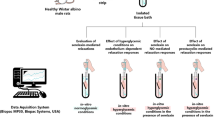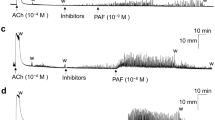Abstract
The isometric tension measurement and in vitro autoradiography were used in clitoral cavernosum smooth muscle (CSM). Angiotensin ANG III, ANG IV, ANG II and ANG I induced contractions in clitoral CSM strips. ANG III and ANG I- induced contraction was five times less active than ANG II, whereas ANG IV-induced contraction was 1181-fold less potent than ANG II. Contractile responses to ANG III, ANG IV, ANG II and ANG I were significantly inhibited by type 1 ANG II (AT 1) receptor antagonist Dup 753 but not by type 2 ANG II (AT2) receptor antagonist PD 123,319. Pre-treatment with Nω-nitro-L-arginine methyl ester, nitric oxide (NO) synthase inhibitor accentuated force of contraction induced by ANG III, ANG IV and ANG II. Amastatin, an aminopeptidase inhibitor enhanced ANG III- and ANG IV-induced contractions. Specific binding sites for 125I-ANG II were found in the clitoral CSM. Specific binding of 125I-ANG II was displaced by unlabeled ANG peptides. This study suggests that the contractile responses to all four peptides of the ANG family are mediated via AT1 receptors but not AT2 receptors. Further, the rank order of potency of contraction was as follows, ANG II> ANG I>ANG III>ANG IV. It is also suggested that peptides of the ANG family have a cross-talk with the NO system and aminopeptidase is involved in the modulation of the tone of clitoral CSM by ANG III and ANG IV.
This is a preview of subscription content, access via your institution
Access options
Subscribe to this journal
Receive 8 print issues and online access
$259.00 per year
only $32.38 per issue
Buy this article
- Purchase on Springer Link
- Instant access to full article PDF
Prices may be subject to local taxes which are calculated during checkout





Similar content being viewed by others
References
Timmermans PB et al . Angiotensin II receptors and angiotensin II receptor antagonists. Pharmacol Rev 1993 45: 205–251.
Harding JW et al . Cerebroventricular and intravascular metabolism of [125I]angiotensins in rat. J Neurochem 1986 46: 1292–1297.
Ahmad S, Ward PE. . Role of aminopeptidase activity in the regulation of the pressor activity of circulating angiotensins. J Pharmacol Exp Ther 1990 252: 643–650.
Park JK et al . Renin angiotensin system in rabbit corpus cavernosum: functional characterization of angiotensin II receptors. J Urol 1997 158: 653–658.
Park SC, Cho KW, Park JK. . Role of renin angiotensin system in clitoral cavernosum smooth muscle. Kor J Urol 2000 42: 387–394.
Park JK et al . Renin angiotensin system of rabbit clitoral cavernosum: interaction with nitric oxide. J Urol 2000 164: 556–561.
Pendleton RG, Gessner G, Horner E. . Comparative effects of antiotensin II and angiotensin III in rabbit adrenal and aortic tissues. J Pharmacol Exp Ther 1991 256: 291–297.
Zhang QLJ, Pfaffendorf M, Van Zwieten PA. . Comparative effects of angiotensin II and its degradation products angiotensin III and angiotensin IV in rat aorta. Br J Pharmacol 1995 116: 2963–2970.
Swanson GN et al . Discovery of a distinct binding site for angiotensin II (3–8), a putative angiotensin IV receptor. Regul Pept 1992 40: 409–419.
Haberl RL, Decker PJ, Einhaupl KM. . Angiotensin degradation products mediate endothelium-dependent dilation of rabbit brain arterioles. Circ Res 1991 68: 1621–1627.
Baker KM, Aceto JF. . Angiotensin II stimulation of protein synthesis and cell growth in chick heart cells. Am J Physiol 1990 259: H610–H618.
Campbell DJ, Kladis A, Valentijn AJ. . Effects of losartan on angiotensin and bradykinin peptides and angiotensin-converting enzyme. J Cardiovasc Pharmacol 1995 26: 233–240.
Laumann EO, Paik A, Rosen RC. . Sexual dysfunction in the United States: prevalence and predictors. JAMA 1999 281: 537–544.
Goldstein I, Berman JR. . Vasculogenic female sexual dysfunction: vaginal engorgement and clitoral erectile insufficiency syndromes. Int J Impot of Res 1998 10: Suppl 2 S84–S90.
Munson PJ, Rodbard D. . LIGAND: a versatile computerized approach for characterization of ligand binding system. Anal Biochem 1980 107: 220–239.
Comiter CV et al . Effect of angiotensin II on corpus cavernosum smooth muscle in relation to nitric oxide environment: in vitro studies in canines. Int J Impot Res 1997 9: 135–147.
Chappel MC et al . Identification of angiotensin-(1–7) in rat brain. Evidence for differential processing of angiotensin peptides. J Biol Chem 1989 264: 16518–16523.
Cohen RB, Webb ML, Dickinson KEJ. . Peptidases and smooth muscle cell angiotensin II receptor pharmacology. Peptides 1993 14: 345–352.
Wright JW, Harding JW. . Important roles for angiotensin III and IV in the brain renin–anigotensin system. Brain Res Rev 1997 25: 96–124.
Nossaman BD et al . Analysis of responses to ANG IV: effects of PD-123319 and DuP-753 in the pulmonary circulation of the rat. Am J Physiol 1995 268: L302–L308.
Feenstra QLM et al . Comparative vasoconstrictor effects of angiotensin II, III, and IV in human isolated saphenous vein. J Cardiovasc Pharmacol 1997 29: 451–456.
Cheng DY et al . Analysis of responses to angiotensin IV in the pulmonary vascular bed of the cat. Eur J Pharmacol 1994 261: 223–227.
Park JK, Cho KW. . Effects of angiotensin III in rabbit corpus cavernosum smooth muscle contraction: comparing with angiotensin I and angiotensin II. Kor J Urol 1999 40: 1219–1224.
Acknowledgements
This study was supported by grants from the Korea Health 21 Research and Development Project, Ministry of Health and Welfare, Republic of Korea (HMP-00-B-21400-0053), Korea Research Foundation (2000-041-F00239) and Alumni Association of Chonbuk National University Medical School.
Author information
Authors and Affiliations
Corresponding author
Rights and permissions
About this article
Cite this article
Park, J., Kim, S., Kim, J. et al. Comparison of effects of angiotensin peptides in the regulation of clitoral cavernosum smooth muscle tone. Int J Impot Res 14, 72–80 (2002). https://doi.org/10.1038/sj.ijir.3900824
Received:
Revised:
Accepted:
Published:
Issue Date:
DOI: https://doi.org/10.1038/sj.ijir.3900824
Keywords
This article is cited by
-
Valsartan treatment reverses erectile dysfunction in diabetic rats
International Journal of Impotence Research (2007)



